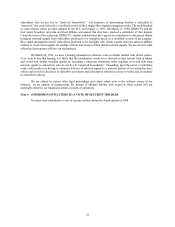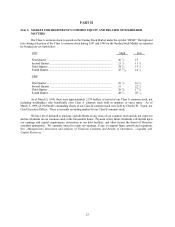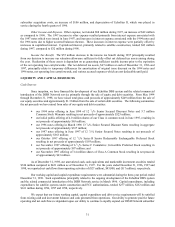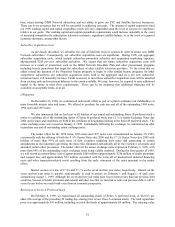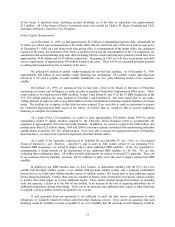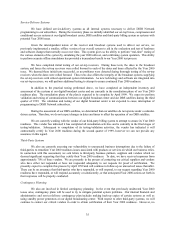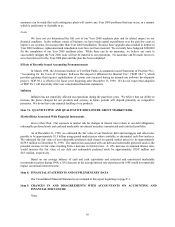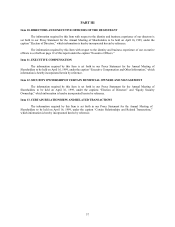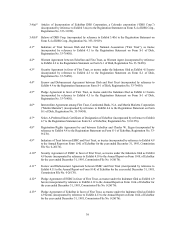Dish Network 1998 Annual Report Download - page 34
Download and view the complete annual report
Please find page 34 of the 1998 Dish Network annual report below. You can navigate through the pages in the report by either clicking on the pages listed below, or by using the keyword search tool below to find specific information within the annual report.32
base, retain existing DISH Network subscribers and our ability to grow our ETC and Satellite Services businesses.
There can be no assurance that we will be successful in achieving our goals. The amount of capital required to fund
our 1999 working capital and capital expenditure needs will vary, dependent upon the level of success we experience
relative to our goals. Our working capital and capital expenditure requirements could increase materially in the event
of increased competition for subscription television customers, significant satellite failures, or in the event of a general
economic downturn, among other factors.
Subscriber Acquisition Costs
As previously described, we subsidize the cost of EchoStar receiver systems in order to attract new DISH
Network subscribers. Consequently, our subscriber acquisition costs are significant. During 1998, our aggregate
subscriber acquisition costs, which include subscriber promotion subsidies and acquisition marketing expenses,
approximated $285 per new subscriber activation. We expect that our future subscriber acquisition costs will
increase as a result of promotions such as the DISH Network One-Rate Plan and other promotional programs
including bounty promotions that target the subscribers of other satellite television providers. To the extent that we
either extend the duration of the PrimeStar bounty program or begin to offer similar bounty programs for other
competitors’ subscribers, our subscriber acquisition costs, both in the aggregate and on a per new subscriber
activation basis, will materially increase. Funds necessary to meet these subscriber acquisition costs will be satisfied
from existing cash and investment balances to the extent available. We may, however, be required to raise additional
capital in the future to meet these requirements. There can be no assurance that additional financing will be
available on acceptable terms, or at all.
Obligations
On December 23, 1998, we commenced cash tender offers as part of a plan to refinance our indebtedness at
more favorable interest rates and terms. We offered to purchase for cash any and all of the outstanding 1994 notes,
1996 notes and 1997 notes.
We also announced that we had sent to all holders of our issued and outstanding Series B preferred stock a
notice to exchange all of the outstanding shares of Series B preferred stock into 12 1/8% Senior Exchange Notes due
2004 on the terms and conditions set forth in the certificate of designation relating to the Series B preferred stock. The
senior exchange notes were issued on January 4, 1999. Immediately following the exchange, we commenced an offer
to purchase any and all outstanding senior exchange notes.
The tender offers for the 1994 notes, 1996 notes and 1997 notes were consummated on January 25, 1999,
concurrently with the offering of both the 9 ¼% Senior Notes due 2006 and the 9 3/8% Senior Notes due 2009 with
holders of more than 99% of each issue of debt securities tendering their notes and consenting to certain
amendments to the indentures governing the notes that eliminated substantially all of the restrictive covenants and
amended certain other provisions. The tender offer for the senior exchange notes expired on February 1, 1999, with
more than 99% of the outstanding senior exchange notes being validly tendered. During the first quarter of 1999,
we will record an extraordinary loss of approximately $269 million (approximately $236 million of tender premiums
and consent fees and approximately $33 million associated with the write-off of unamortized deferred financing
costs and other transaction-related costs) resulting from the early retirement of the notes pursuant to the tender
offers.
Interest accrues at a rate of 9 ¼% and 9 3/8% on the seven and ten year notes, respectively. Interest on the
seven and ten year notes is payable semi-annually in cash in arrears on February 1 and August 1 of each year,
commencing August 1, 1999. Although the seven and ten year notes have lower interest rates than our previous debt
securities, because of tender premiums and consent and other fees that we incurred to retire our previous debt, it will be
several years before we reach break-even from an economic perspective.
Retirement of Series A Preferred Stock
On February 8, 1999, we repurchased all outstanding shares of Series A preferred stock, at $52.611 per
share (the average of the preceding 20 trading day closing price of our Class A common stock). The total repurchase
price was approximately $91 million, including accrued dividends of approximately $6 million. The carrying value


